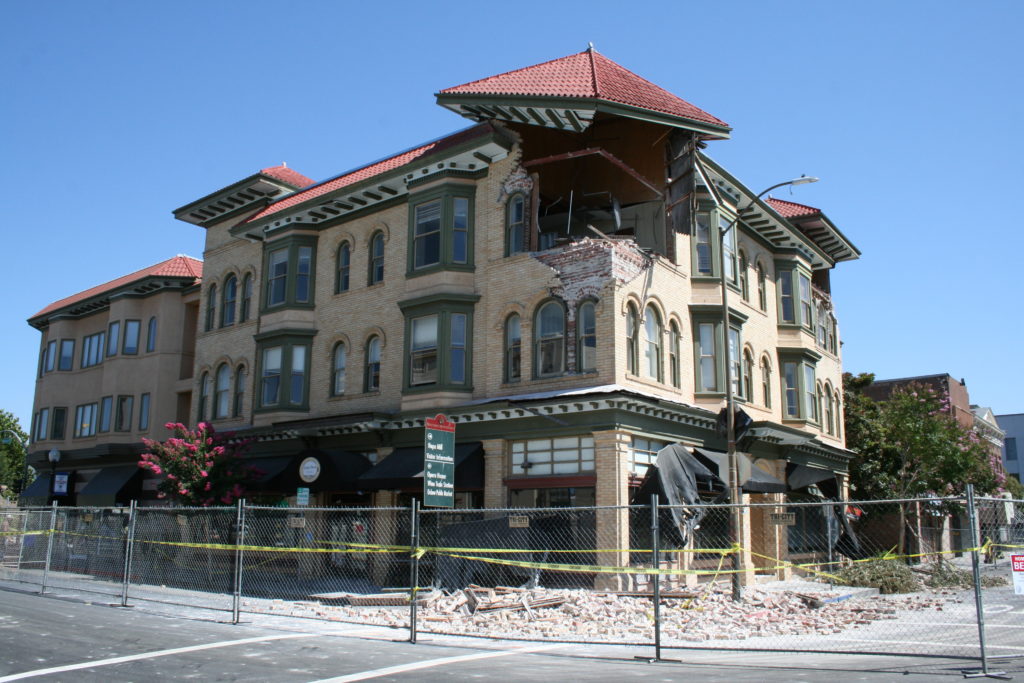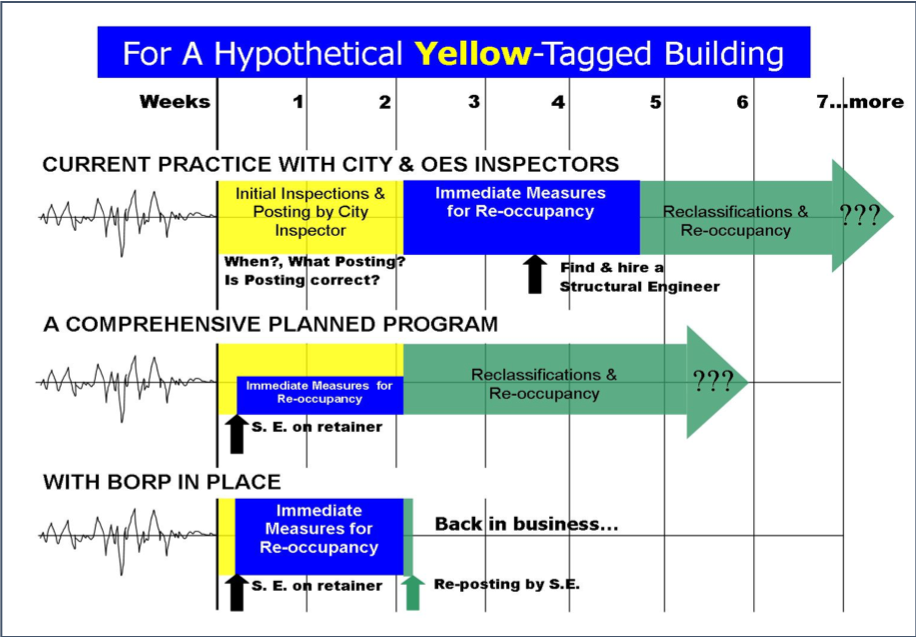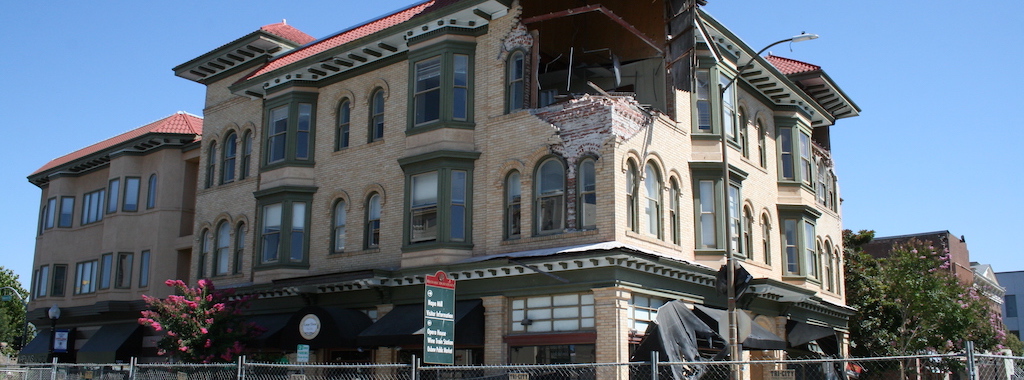How can a “Back-to-Business” plan help communities and business owners recover after a damaging event? In this guest blog post, David Cocke, S.E., explores the history of “B2B” programs and how they help expedite the inspection process so owners can get back to normal faster.
Business leaders have a lot to think about nowadays. With the current pandemic crisis, we have to consider health (ourselves, our families and our staff), liabilities, cash flow, workload, client retention and the pipeline for future work. Knock on wood that we don’t have to deal with any kind of natural disaster on top of this current situation, but more on that topic later…
The current crisis reminds me that we as business owners do have to consider all potential threats to our business continuity and if possible put together plans for resiliency against those threats. In the structural engineering world, we’re regularly designing structures for normal operating loads, but in addition we have to consider the unusual “shock” loading conditions that can occur in earthquakes, windstorms and floods. We have building codes and standards that help us to design and strengthen structures so they have a better chance to meet the performance objectives desired by the owners. Of course, we have to do a good job of informing the owners about what those objectives really mean — what should they expect in a significant event?

Regardless of the high level of care that we take during evaluation and design of structures, we as structural engineers also have a responsibility to respond after an event to help with recovery. Structural Engineers are there to help with the assessment of structures after a damaging event. The local building jurisdiction typically has sole authority to determine whether a structure is safe for reoccupancy by inspecting and then posting the building with a green (safe), yellow (occupancy restricted) or a red (unsafe) tag.

The difficulty is that local building jurisdictions’ inspection capacity can be quickly overwhelmed in a large regional event. Several years after the 1989 Loma Prieta earthquake in northern California, the San Francisco building department and local structural engineers association (SEAONC) conceptualized a Building Occupancy Resumption Program (BORP) to supplement the building department capacity. That program allows for a three-way agreement between the City, a building owner and a designated structural engineer. That agreement enables automatic deputation of the designated structural engineer so that he or she is legally authorized to post a particular building as green, yellow or red .
While the BORP concept was adopted within a few years by several jurisdictions in the Bay Area, it did not spread to southern California until Dreamworks Animation and the City of Glendale worked with Structural Focus to establish a version of BORP called Back-to-Business (B2B) in 2013. Since then several other southern California jurisdictions have established their B2B programs and several large building owner clients have implemented the program.
While providing our structural engineering services for evaluation, retrofitting and new design, we have had numerous conversations with our clients about their exposure to risks related to their facilities:
Safety — Above all else, building owners have a responsibility to ensure the safety of the occupants in their buildings, as well as the safety of people who may be near the exterior of the building at the time of an earthquake.
Damage — The cost of repairs for owners to restore their buildings to their pre-earthquake condition can be significant, and, depending on the severity of the damage, total reconstruction may be necessary and the business could take years to recover.
Downtime — Even a brand-new building may not be usable after an earthquake — either because physical damage prevents its proper function, or because the occupants’ perception of their personal risk is too high, causing them to refuse to enter the building. The cost of business interruption can vastly exceed the cost of repairs. If repairs need to be made, the time to make those repairs can be significant and may directly result in business interruption losses. Similarly, if the damage is so severe that the building must be demolished and replaced, the resulting business interruption may be many months to several years. Previous disasters have shown this situation often results in permanent relocation, or even spells the end of the affected businesses and lasting harm to the community.
With a B2B program in place, weeks if not months of business interruption can be saved at least during the inspection phase. Building owners will have more confidence that their buildings will be inspected right away without waiting for the city inspectors, and they will have confidence that it is a thorough and accurate inspection because the engineer will have already studied the building and have notes for use during the post-earthquake inspection. Because of these differences, they can also expect significantly reduced their building downtime.
The following steps are suggested to put a program in place:
- The owner receives a description of the B2B program from the B2B engineer and requested to endorse the concept and join the B2B engineer at the table for an introductory meeting with the local building department.
- If the owner has multiple buildings, they will be asked which of those they wish have included in the program.
- The B2B engineer is to evaluate the selected building(s) and prepare a file for each to use in a post-earthquake inspection.
- B2B engineer prepares and submits B2B building applications, including the building files, to the building department.
- B2B engineer organizes annual updates to meet the owner’s and building department’s requirements.
The owner’s costs of this program include the structural engineering fees and the building department fees to review and the approve the applications. Of course, from a risk management perspective, those upfront program costs are minimal compared to the potential business interruption costs and other risks associated with an earthquake.

With a B2B program in place, the building owner has significantly reduced his or her risk, the building department can reduce the number of facilities that they have to inspect (and concentrate their resources elsewhere), and the community’s potential downtime can be reduced. At the same time, pre-event evaluations have often led to needed retrofits based on the structural engineer’s evaluation results. Building owners have commented positively about their increased ability to “control their own destiny” with a B2B program in place. We cannot predict when an earthquake will occur, but with the advance planning of a B2B program and other activities, we can help building owners reduce their exposure.
So in closing, do we dare to surmise what would happen if a significant earthquake occurred while we are dealing with this pandemic? We have observed in the last couple of months that, generally, local building departments have converted to mostly remote and virtual processes, and we can only assume that they would be severely pressed to provide adequate and timely post-earthquake building inspections. And certainly their priority inspections will have to go to essential facilities, including temporary housing and health-related facilities. A B2B program in place would backfill the sorely needed inspections to expedite reoccupancy in commercial buildings. But let’s just hope we business owners won’t have to deal with that scenario on top of a pandemic.
David Cocke, S.E. has been practicing Structural Engineering since 1981. David founded Structural Focus in 2001 after 20 years at Degenkolb Engineers. He is a registered Structural Engineer in California and several other states, with expertise in seismic evaluation, historic preservation, retrofits and new design.
David is very involved in numerous professional associations. He joined the Earthquake Engineering Research Institute in 1992 and is a Charter Member of the Southern California Chapter, has served on the EERI Board of Directors and is the current President-Elect of the organization. David has served on the Board of Directors of numerous other organizations including the California Preservation Foundation, Pasadena Heritage, USC Architectural Guild, SEAONC, SEAOSC, and SEAOC, and is currently on the Board of Los Angeles Conservancy. He is also on the Board of Governors of the Structural Engineers Institute (SEI) of ASCE and is the Immediate Past President of that organization. Starting in 2007, David has served as the SEAOC appointed Alternate Structural Engineer Member on the California Historical Building Safety Board.
David has been leading the effort to bring Back to Business (B2B), a building occupancy resumption program, to southern California. In 2013, his team worked with DreamWorks to establish southern California’s first B2B in the City of Glendale. Now the team is partnering with a multitude of clients and cities throughout Southern California to establish their B2B programs. David serves as the Managing Director of SAFEq Institute, an organization devoted to assisting local governments with the establishment of B2B programs.
SAFEq™ Institute is an expert resource for building owners, risk managers, engineers, and local jurisdictions seeking to minimize facility and business interruption losses caused by disasters. SAFEq™ Institute promotes the adoption of the Back to Business (B2B) Program by helping local jurisdictions understand and establish guidelines for their own B2B and reviewing and recommending approval of B2B applications. The Institute seeks to keep those who provide emergency inspection in a “ready” state by ensuring they have the most current knowledge of the state of practice of emergency building evaluation and facilitating sharing of real-world post-disaster experiences.





1 thought on “Business Owners Today: What Else Could Happen?”
Comments are closed.